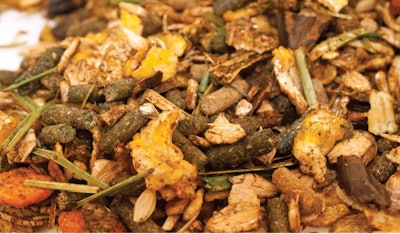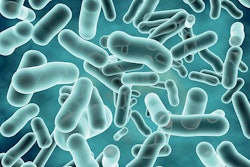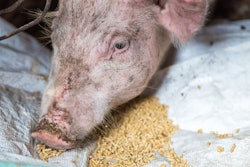
Price alone is a poor indicator of how calves will receive a starter feed, but skimping on quality is a sure way to invite problems.
Along with a form of a liquid milk (whole or skimmed milk, or a milk replacer), newborn calves are offered a dry starter feed after their first week of life.
This is done to entice them to eat dry feed that naturally will end up in the rumen. There, it will help the maturation of this compartment and establish a healthy microbiota. The sooner the rumen develops, the sooner the calf can be weaned off from expensive milk-type products.
In general, for a weaning period of eight weeks, calves will consume an equal amount of dry feed from milk or milk replacer and starter. In most nutrition programs, this equates roughly to about 100 pounds milk powder (not liquid) and 100 pounds of starter feed. This is an oversimplified estimation, but it is a good starting point for doing initial calculations.
Apart from the amount of starter feed, one has to consider its quality in many different terms. Lamentably, as the cost of milk and milk replacer products is becoming prohibitive, many producers opt for lower-cost starter feeds, and often end up paying the difference in medical expenses when calves break out with diarrheas. In most cases, however, calves simply do not grow as fast or strong as desired and the real problem is masked by the overall depressed health condition.
The following can help as a guideline in selecting a good quality calf starter.
Form
There are three possible forms of calf starters. The traditional, and least expensive, is that of a meal type composed primarily of corn (or other cereals) and soybean meal (or other protein sources). This is supplemented, more often than not, with minerals, vitamins, trace minerals and certain additives. It may be or not medicated according to local regulations.
Intake of this meal-type feed is satisfactory assuming milk or milk replacer intake falls short of animal requirements. In other words, there is nothing special that will entice calves to consume it. In fact, calves are known to dislike meal feeds, especially finely ground ones. Thus, quite often, corn is offered cracked, but this causes separation of the finer and most expensive ingredients that remain in the bottom of the feeder.
The second option is that of a pellet, almost invariably of the same design as a meal feed. Quite often molasses is added which, although not needed, entices calves to consume dry feed earlier than otherwise with meal. Pellets are more expensive, but they avoid the problem of ingredient separation and allow the inclusion of more expensive additives.
Finally, the third and most expensive option is textured feed, or a muesli-looking product. In its simplest form, it is the same design as any of the above with all the ingredients but corn being pelleted. Corn is then mixed with the pellets either whole, cracked or flaked. Best quality products include steam-flaked corn. More elaborate designs include several protein and energy seeds included in the loose part of the mix, either flaked or whole. The entire mix is sprayed with molasses and/or oil to avoid separation and increase feed intake. Of course, the cost is even higher than for pelleted feed, but many producers notice the higher feed intake in their calves.
Composition
There are plenty of composition tables describing the nutrient specifications of calf starters, but the most important nutrient today is protein. In the beginning, when calves were switched from whole milk feeding to skim milk feeding (as the latter was less expensive to feed), the starter dry feed was viewed a major source of energy. This was because the milk fat (butter) had been removed and the dry feed needed to replenish the gap in energy intake.
Today, most calves are fed on liquid milk replacer products that often lack in sufficient protein or the allowance of such milk replacers is limited. This limitation is imposed either as a way to force calves to consume dry feed earlier, or because these milk replacer products have become too expensive. Either way, a traditional calf starter contains about 18% crude protein, but experimental results have shown a positive response up to 26% protein. Of course, the protein concentration of the starter should not be taken alone but always in consideration as part of the whole nutrient intake of the calf daily.
Ingredient quality
Even more important than nutrients and form of feed is the type and quality of the actual ingredients used. Low quality (often due to cost considerations) can ruin the best formula and will yield unsatisfactory results even if offered as textured feed. Adding extra molasses will not mask problems for long as anti-nutritional and other contaminants will impair calf health, often leading to diarrhea, unthriftiness, and even loss of appetite and weight.
Only the best quality ingredients should be selected and, for that, it is important to ensure they contain the least amount of anti-nutritional and allergenic factors as calves are quite sensitive to them. Producers should not skimp on cost because the quality of a starter (as that of the milk replacer) is an investment and not an expense only. A good start in life is a sound basis for prosperity.
Additives
Most feed professionals recommend adding a yeast product in calf starters to help the rumen microbiota. Others prefer to wait until the calf is weaned, whereas others prefer to include it in the milk replacer. In any case, care should be taken not to overdose the animal. Some specific ingredients, such as linseed, are used as a type of additive in light of their functional properties in helping developing the immature rumen, but again, such ingredients are rare and quite expensive, and the exact dosage remains often proprietary information. Most other commercial additives are extensively advertised as suitable for inclusion in calf starters, but which one to use is the realm of the local feed professional who designs each formula.
Vitamins and trace minerals
Whether to add a premix of vitamins and minerals in the calf starter is a good topic of discussion. First, if the milk replacer contains a full complement of these micro-nutrients, one can question their usefulness in the starter feed, especially if a step-down milk replacer program is not followed. There is no consensus on which of these nutrients need to be added or at what level. Most nutritionists will add a moderate level of all vitamins and trace minerals, especially when they have no control or knowledge how this feed will be used.
As these nutrients are not overly expensive, this safety measure is deemed acceptable. In some cases, certain vitamins and/or trace minerals may be added to boost animal health, but then we are back to the area of additives as such use is beyond the scope of basic nutrition.
Molasses
As previously mentioned, ruminants do not need molasses. In fact, they do not secrete sucrase, the enzyme needed to break down sucrose that is half of the sugars in molasses. Nevertheless, a moderate amount of molasses is added even in pre-ruminant calves to entice them to consume the starter feed. Too much molasses will cause handling problems, so 2-4% is an acceptable number for most starter products.
Evaluate a dairy calf milk replacer program in 3 easy steps: https://bit.ly/2YWrM6L















